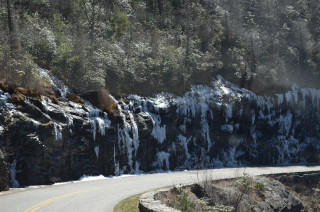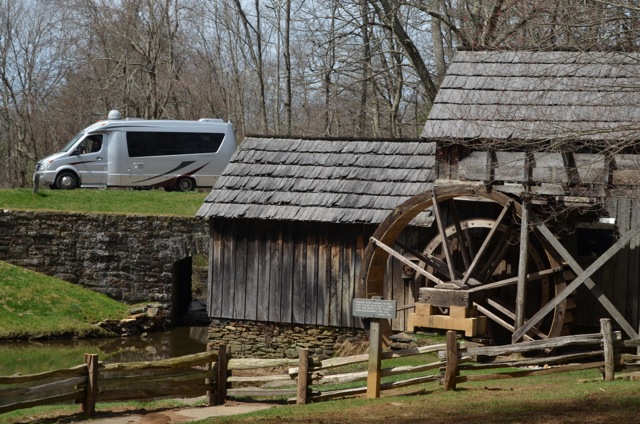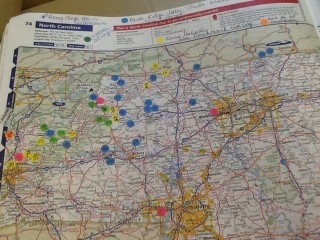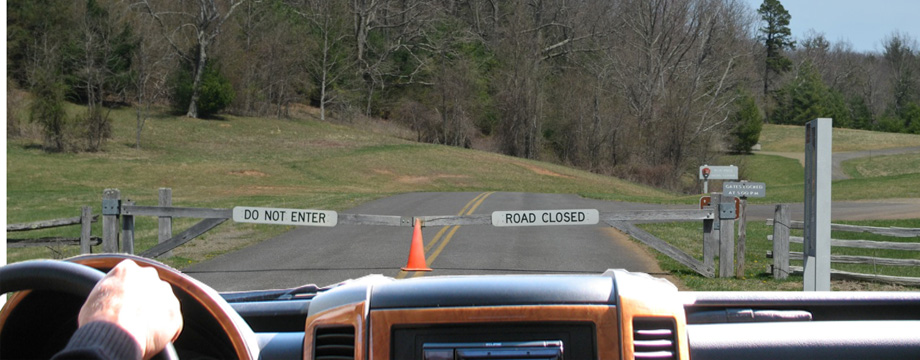We couldn’t wait to get to the scenic Skyline Drive and Blue Ridge Parkway, but we quickly found out that leaving in early spring has its downside.

Icy cold
Almost all of the National parks were closed until May, the flowers hadn’t blossomed, the trees were still bare and the air was icy cold.
We did have one small stroke of luck, however. Although not officially opened for the season, the picturesque Mabry Mill was not gated, and access to the grounds was allowed. Not only were we able to roam around the restored mill and other relics of rural life in Appalachia, but we had a pleasant evening boon docking on the property. In the morning, the sun was shining on Serena and we got this great calendar shot.

Serena at Mabry Mill
Please view and comment on this picture in the 2014 LTV Annual Photo Contest here.
The good news is, when we entered North Carolina, we discovered that in the Blue Ridge Mountains, the music is always open! People here play music for their own pleasure all year long. I had purchased a book called the Blue Ridge Music Trails of North Carolina, hoping to find small venues where we could see real people playing real music in real time, not artificial settings and schedules created for the tourists. All the blue dots in my handy Rand McNally map book indicate locations where music is played in the areas where Manny and I hoped to be.

NC Rand McNally Map
We started our quest in the college town of Boone, where the legendary Daniel Boone is said to have camped and where the famous Doc Watson used to perform for pocket change on the city’s main thoroughfare, King Street. We headed for the Jones House, a historic residence built in 1908. The stately home is now owned by the city of Boone, which turned the noble two story building into a community center that hosts gallery exhibits by emerging artists and Thursday night jam sessions attended by local musicians.
The music was in full swing when we arrived and the players generously allowed us to film their session. They were so in sync with each other that we assumed they played together frequently. This was not the case, and one of the players informed us that each instrument has its role and as long as the musician follows his or her part, they are able to play with anyone. He likened it to playing basketball, where each player has his position and knows what he has to do and when to do it.
Manny and I thought that we were hearing bluegrass but we were quickly corrected. They were playing old time country. What’s the difference? In old time, the fiddle takes the lead and all the players play at the same rate; they play as a unit. In bluegrass, each instrument is spotlighted in turn and the focus shifts from one player to the next, a feature of bluegrass known as break-taking.
Another big difference is that bluegrass is meant to be listened to while old time country’s driving beat is usually meant for dancing. And boy did we find this out. At the Jones House, we met one of the friendly and very accomplished musicians, John Peterson. John just keeps carryin’ on. He not only makes the fretless banjoes he plays so fluidly, but he is a caller and dancer at a square dance in his small town of Todd, just 11 miles north of Boone. The dance takes place once a month at one of the historic local buildings, Todd Mercantile, and we were lucky enough that it was the very next night. We arrived at the charming bakery and café just in time to “get down” country style.



9 Responses to The music never closes